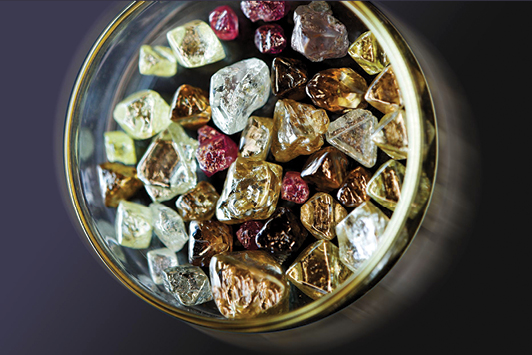 Udachny: Larisa Popugayeva and Natalya Sarsadskikh
Udachny: Larisa Popugayeva and Natalya Sarsadskikh
In the 1940s, Russia was in need of diamonds for industrial uses and was funneling a fortune into importing them from abroad. Diamonds had been discovered in the tributaries of Siberia’s Nizhnyaya Tunguska River, but the kimberlite pipes that produced these treasures eluded geologists until the arrival of two persevering women: Larisa Popugayeva and Natalya Sarsadskikh.
Sarsadskikh joined the search in 1950. Uninspired by the strategies the Amakinskaya Geological Expedition was employing, Sarsadskikh, who was the leader of an exploration party, developed her own search parameters. She believed that pyropes — naturally red garnets — were always found near kimberlite pipes. Though her methodology would prove to be sound, the search remained fruitless until the arrival of recent graduate Popugayeva in 1953.
Not long after, Popugayeva found a diamond-bearing pyrope, but by the time it was confirmed in 1954, their funding had been cut. Frustrated, Sarsadskikh, who was at this time close to giving birth, turned to Ivan Krasnov at the Karpinsky National Research Institute of Geology. He agreed to fund further exploration, but there was a tradeoff: Popugayeva had to join his expedition to hunt for kimberlites near the Daldyn River.
Popugayeva agreed, giving up both her plan for post-graduate study and a pregnancy to do so. During her search in Daldyn, while lying on the ground studying moss with a magnifying glass, she made a geological discovery that would transform Russia’s fortunes forever: the Zarnitsa pipe in Udachny, the first diamond deposit in the Soviet Union. However, the male leaders of the Amakinskaya expedition stole the credit for this discovery of Russian diamonds, and the ostracized Popugayeva and Sarsadskikh had to wait decades for proper recognition.
Argyle: Maureen Muggeridge
One geologist who managed to use her femininity to her advantage while diamond hunting was Maureen Muggeridge, who was part of the team that discovered the Argyle diamond mine in Australia during the 1970s. She was six months pregnant when hunting for kimberlite in the Smoke Creek region, where De Beers had reportedly already spent GBP 10 million on exploration with no success. To keep other prospectors in the area off her trail, her team, the Ashton Joint Venture, spread the word that Muggeridge was on maternity leave. She was not. Instead, she was exploring the flood plains of Smoke Creek, a small river that fed into the Argyle Lake. “It all had to be hush-hush,” she once said. ‘‘You couldn’t say you were looking for diamonds, because that would spark too much interest. I felt like a character in a James Bond movie or a Wilbur Smith novel.”
It has become legend that Muggeridge, who died in 2010 while sampling for diamonds at Napier Downs, found diamonds in the creek, though current Argyle owner Rio Tinto downplays her involvement. While acknowledging that she was on the exploration team, the mining company claims she left before the discovery was actually made.
Diavik: Eira Thomas
Eira Thomas, who joined Lucara Diamond Corp. as chief executive last year, has her own diamond-hunting story, but in a radically different climate from Muggeridge’s.
At the age of 21, fresh out of university with a degree in geology, she received a phone call from her father, Grenville Thomas, in 1991. He asked her to join his Aber Resources team prospecting for diamonds in Northern Canada.
Though she has joked that she questioned his sanity at the time — Canada not yet being known for diamond deposits — he was buoyed by news of the diamonds Chuck Fipke and Stu Blusson had found in the Northwest Territories that year. The terrain was harsh, and while many prospectors pulled out of the frozen landscape after spending millions on unsuccessful exploration ventures, Aber Resources remained. In the spring of 1994, a team led by Eira Thomas drilled through the melting ice, grasping the last opportunity of the season. When the drill core emerged, it held a 2-carat diamond.
That spot would go on to become the Diavik mine, which commenced production in 2003 and has an annual output of up to 7 million carats of gem-quality white diamonds.
Image: A selection of colored diamonds from the Argyle mine - Rio Tinto. Article from the Rapaport Magazine - May 2019. To subscribe click here.